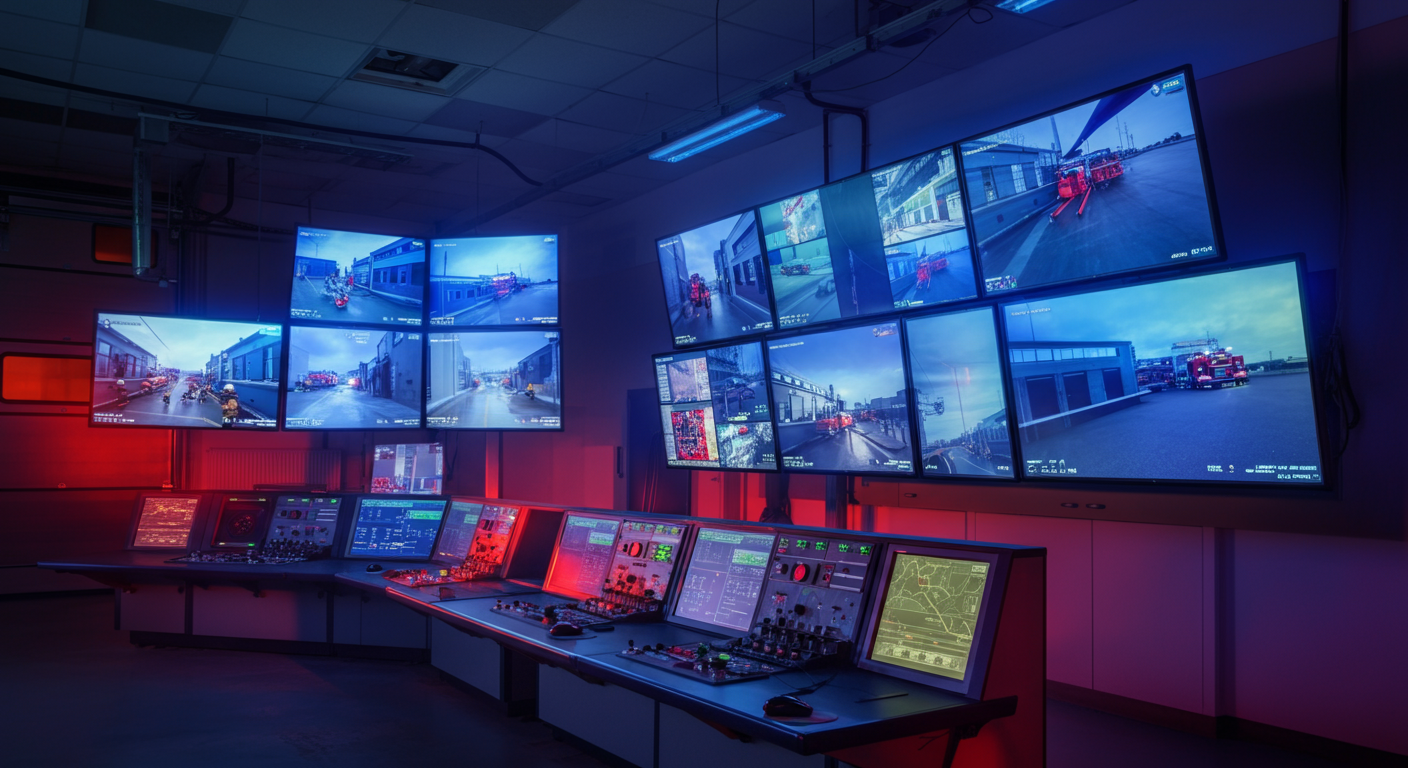In the fast-paced world of emergency services, fire departments face unique challenges that require innovative solutions. One such solution gaining traction is the use of video programming strategies. Imagine a tool that not only boosts the morale of your team but also significantly enhances operational efficiency. This is not just a dream; it’s a reality many fire departments are beginning to embrace.
Why is video programming so pivotal for fire departments? The answer lies in its ability to provide consistent and engaging training, ensure clear communication, and offer real-time insights during operations. As the saying goes, “a picture is worth a thousand words,” but a well-crafted video can be worth even more. By integrating video programming into their routines, fire departments can improve performance, foster teamwork, and maintain high morale among their members.
At DLM Media, we understand the critical role that tailored video content plays in addressing these needs. Our mission is to provide fire departments with reliable and effective video programming solutions that cater to their specific requirements. Whether it’s through comprehensive training modules or live-streamed operational footage, our expertise ensures your department stays ahead of the curve.
In this blog post, we will explore the transformative impact of video programming strategies for fire departments. We’ll delve into how these strategies can be implemented effectively, the benefits they offer, and real-world examples of success. Stay with us as we uncover the potential of video programming to revolutionize fire department operations and morale.
The Role of Video Programming in Fire Department Training
In the realm of fire department training, video programming strategies have emerged as a transformative tool, offering consistent and accessible learning materials. These strategies not only enhance the efficiency of training programs but also ensure that all personnel receive uniform instruction, regardless of their location or schedule. By leveraging video tools, fire departments can maintain a high standard of training, ultimately leading to improved performance on the ground.
One of the key advantages of using video programming in training is its ability to provide a consistent message across the board. Unlike traditional methods, where variations in instruction can occur, video ensures that every firefighter receives the same information and skill demonstrations. This consistency is crucial in emergency situations, where precise execution of skills can make a significant difference in outcomes.
Enhancing Training Efficiency with Video Tools
Video tools have revolutionized the way fire departments conduct training sessions. By utilizing high-quality video content, departments can create engaging and informative modules that cater to various learning styles. These videos can be accessed on-demand, allowing firefighters to learn at their own pace and revisit complex topics as needed.
Moreover, video programming facilitates the integration of real-life scenarios into training modules. For instance, departments can use footage from past incidents to analyze and learn from real-world situations. This approach not only makes training more relatable but also helps in developing critical thinking and decision-making skills among firefighters.
Case Studies: Successful Integration of Video Programming
Several fire departments have successfully integrated video programming into their training regimens, yielding impressive results. For example, a department in California utilized video tools to simulate fireground scenarios, allowing trainees to visualize and respond to various challenges. This method proved effective in enhancing the trainees’ situational awareness and preparedness.
Another notable case is a department in Texas that employed video lectures for theoretical training. By providing consistent, high-quality content, they ensured that all personnel received the same level of instruction, regardless of their shift or location. This approach not only improved knowledge retention but also fostered a culture of continuous learning within the department.
Benefits of Video for Consistent Messaging and Skill Demonstration
The use of video in training offers numerous benefits, particularly in terms of delivering consistent messaging and skill demonstration. Videos can be replayed multiple times, allowing firefighters to master techniques at their own pace. This flexibility is especially beneficial for complex skills that require repeated practice.
Furthermore, video programming enables departments to standardize their training content, ensuring that all personnel are equipped with the same knowledge and skills. This uniformity is essential in maintaining operational efficiency and safety during emergency responses. By investing in video programming strategies, fire departments can significantly enhance their training outcomes and overall effectiveness.
For more insights into how video programming can transform your fire department’s training, explore our comprehensive resources at DLM Media.
Enhancing Communication with Video Programming
In the dynamic environment of fire departments, effective communication is paramount. Whether during high-stakes emergencies or routine operations, the ability to convey clear and timely information can significantly impact outcomes. This is where video programming strategies for fire departments come into play, offering a robust solution to enhance communication across various scenarios.
Video programming serves as a versatile tool, enabling real-time decision-making and ensuring that all team members are on the same page. By integrating video into their communication strategies, fire departments can improve coordination, reduce misunderstandings, and ultimately enhance their operational efficiency. Let’s explore how video programming can revolutionize communication within fire departments.
Role of Video in Emergency Communication
During emergencies, the ability to communicate swiftly and effectively is crucial. Video programming provides a unique advantage by offering visual context that can complement verbal instructions. For instance, live video feeds from drones or body cameras can provide incident commanders with a comprehensive view of the scene, allowing them to make informed decisions without delay.
Moreover, video can bridge the gap between different teams working on-site and those at the command center. By streaming live footage, all parties involved can access the same real-time information, ensuring that decisions are based on the most accurate and up-to-date data. This not only enhances the speed of response but also improves the overall safety of operations.
Examples of Video Use in Real-Time Decision-Making
Several fire departments have successfully leveraged video programming to enhance their decision-making processes. For example, during a recent wildfire, a department utilized drones equipped with thermal imaging cameras to monitor fire spread and identify hotspots. This real-time data allowed commanders to allocate resources more effectively and prioritize evacuation efforts.
In another instance, a department used video conferencing tools to coordinate with neighboring departments during a multi-agency response. By sharing live video feeds and maps, they were able to synchronize their efforts and streamline communication, resulting in a more efficient and cohesive operation.
Diagramming Communication Processes Enhanced by Video
To illustrate the impact of video programming on communication processes, consider a typical emergency response scenario. Initially, video feeds from drones provide a bird’s-eye view of the incident, which is then relayed to the command center. Commanders analyze the footage and communicate strategies to field teams via video conferencing tools, ensuring everyone is aligned on the action plan.
This seamless integration of video into communication workflows not only enhances situational awareness but also fosters a culture of transparency and collaboration. By visualizing the flow of information, departments can identify potential bottlenecks and optimize their communication strategies accordingly.
For more insights on how video programming can transform your fire department’s communication strategies, explore our resources at DLM Media.
Boosting Morale through Engaging Video Content
Fire departments face unique challenges that can impact the morale of their personnel. Engaging video content offers a powerful solution to uplift spirits and foster a positive work environment. By leveraging video programming strategies for fire departments, departments can create motivational and educational content that resonates with their teams.
Videos can serve as a medium for storytelling, allowing departments to share inspiring stories of heroism and teamwork. These narratives not only boost morale but also reinforce the core values and mission of the department. Additionally, video content can be used to recognize individual achievements, celebrate milestones, and build a sense of community among team members.
The Psychological Benefits of Engaging Video Content
Engaging video content can have profound psychological benefits for fire department personnel. Videos that highlight positive outcomes and success stories can enhance motivation and job satisfaction. According to a study published in the “Journal of Occupational Health Psychology,” exposure to positive media content can improve mood and increase resilience among emergency responders.
Moreover, video content that includes testimonials from peers or leaders can create a sense of belonging and validation. When firefighters see their colleagues sharing experiences and expressing appreciation, it fosters a supportive atmosphere that encourages open communication and collaboration.
Types of Video Content That Boost Morale
To effectively boost morale, fire departments can incorporate various types of video content into their programming. Motivational videos featuring real-life success stories and testimonials from fellow firefighters can inspire and uplift the team. These videos can highlight the impact of their work on the community, reinforcing the importance of their roles.
Educational videos that offer personal development opportunities can also enhance morale. By providing access to training resources and skill-building content, departments empower their personnel to grow professionally. This investment in their development signals that the organization values their contributions and is committed to their success.
Incorporating Motivational Stories and Testimonials
Incorporating motivational stories and testimonials into video content is an effective way to boost morale. Fire departments can create a series of videos that showcase individual and team achievements, highlighting the dedication and bravery of their personnel. These stories can serve as a reminder of the positive impact they have on their communities.
Testimonials from firefighters sharing their personal experiences and challenges can also resonate deeply with viewers. By providing a platform for team members to express their thoughts and feelings, departments can foster a culture of openness and support. This approach not only boosts morale but also strengthens the bonds between team members.
For more insights on how to implement effective video programming strategies, visit our resources at DLM Media.
Empowering Fire Departments with Video Strategies
In today’s rapidly evolving emergency services landscape, video programming strategies for fire departments are proving to be a game-changer. By embracing these innovative tools, departments can significantly enhance their training, communication, and morale. The essence of these strategies lies in their ability to deliver consistent, engaging content that transforms how fire departments operate.
Video programming enhances training by ensuring that all personnel receive uniform and high-quality instruction. This consistency is crucial in maintaining operational efficiency and safety during emergencies. Moreover, video tools allow departments to incorporate real-life scenarios into their training modules, fostering critical thinking and decision-making skills among firefighters.
In terms of communication, video programming offers a robust solution for real-time decision-making. By streaming live footage from drones or body cameras, incident commanders can access comprehensive views of scenes, leading to informed and timely decisions. This integration ensures that all team members are aligned and enhances the overall effectiveness of operations.
- Consistent Training: Video ensures all firefighters receive the same high-standard training.
- Real-Time Communication: Live video feeds improve decision-making and coordination.
- Boosted Morale: Engaging content uplifts team spirit and reinforces core values.
As fire departments continue to navigate complex challenges, adopting video programming strategies is not just beneficial—it’s essential. By investing in these innovative solutions, departments can boost morale, enhance efficiency, and ensure the safety of their personnel. We invite you to explore the possibilities of video programming further at DLM Media. Let us help you transform your department with tailored solutions that meet your specific needs.
Discover more about how video programming can revolutionize your fire department by visiting our website. Join the conversation and share your experiences or questions in the comments section below. Together, let’s advance the future of fire department operations.





